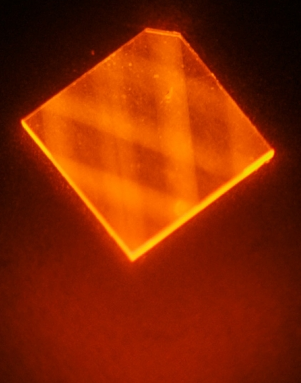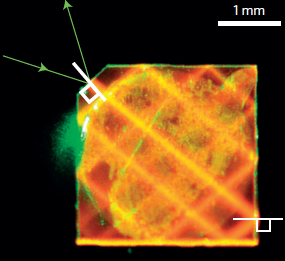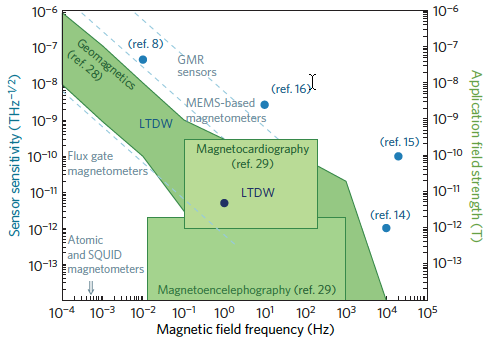MIT invents ultrasensitive magnetic-field detector
April 7, 2015

In this image, laser light enters a synthetic diamond from a facet at its corner and bounces around inside the diamond until its energy is exhausted. This excites “nitrogen vacancies” that can be used to measure magnetic fields. (credit: H. Clevenson/MIT Lincoln Laboratory)
MIT researchers have developed a new, ultrasensitive magnetic-field detector that is 1,000 times more energy-efficient than its predecessors. It could lead to miniaturized, battery-powered devices for medical and materials imaging, contraband detection, and even geological exploration.
Magnetic-field detectors (magnetometers) are already used for all those applications. But existing technologies have drawbacks: Some rely on gas-filled chambers; others work only in narrow frequency bands, limiting their utility.
Synthetic diamonds with nitrogen vacancies (NVs) — defects that are extremely sensitive to magnetic fields — would offer a solution. A diamond chip about one-twentieth the size of a thumbnail could contain trillions of nitrogen vacancies, each capable of performing its own magnetic-field measurement.
The problem has been aggregating all those measurements.
Probing a nitrogen vacancy requires zapping it with laser light, which it absorbs and re-emits. The intensity of the emitted light carries information about the vacancy’s magnetic state.
“In the past, only a small fraction of the pump light was used to excite a small fraction of the NVs,” says Dirk Englund, the Jamieson Career Development Assistant Professor in Electrical Engineering and Computer Science and one of the designers of the new device. “We make use of almost all the pump light to measure almost all of the NVs.”
The MIT researchers report their new device in the latest issue of Nature Physics.
How to detect magnetic fields with nitrogen vacancies
As reported on KurzweilAI, nitrogen-vacancy defects have important potential applications, including noninvasive real-time magnetic brain-wave studies, temperature measurement of living cells, quantum computing and networks, and data storage.
A pure diamond is a lattice of carbon atoms, which don’t interact with magnetic fields. A nitrogen vacancy is a missing atom in the lattice, adjacent to a nitrogen atom. Electrons in the vacancy do interact with magnetic fields, which is why they’re useful for sensing.
When a photon strikes an electron in a nitrogen vacancy, it kicks it into a higher energy state. When the electron falls back down into its original energy state, it may release its excess energy as another photon. A magnetic field, however, can flip the electron’s magnetic orientation, or spin, increasing the difference between its two energy states. The stronger the field, the more spins it will flip, changing the brightness of the light emitted by the vacancies.
Making accurate measurements with this type of chip requires collecting as many of those photons as possible. In previous experiments, researchers often excited the nitrogen vacancies by directing laser light at the surface of the chip. But only a small fraction of the light is absorbed, say the researchers. Most of it just goes straight through the diamond.
The fix

New light-trapping diamond waveguide consists of a rectangular diamond slab with a small angled facet at one corner for input coupling of the green 70mW pump laser, with resulting bright fluorescence. (credit: Hannah Clevenson et al./Nature Physics)
The fix was to add a prism facet to the corner of the diamond and couple the laser into the side. That allowed all of the light inserted into the diamond to be absorbed.
Because of the geometry of the nitrogen vacancies, the re-emitted photons emerge at four distinct angles. A lens at one end of the crystal can collect 20 percent of them and focus them onto a light detector, which is enough to yield a reliable measurement.
“NV centers are very nice to work with,” says Frank Narducci, a physicist at the U.S. Naval Air Systems Command. “You just have this little solid-state sample. You don’t have to do anything to it. You don’t have to put it in a vacuum. You don’t have to cryogenically cool it.
“To get them excited, you can just use a green laser — a laser pointer is good enough. You don’t have to have anything super-fancy in the way of stabilized lasers.
“What’s cool about this is that they’re using the sample itself kind of like a waveguide, to bounce the light around. Their sample is quite small. Because the laser doesn’t have to be anything particularly special, that could be small, too. So you could envision very small magnetometers. And correspondingly, you could make them very cheap.”
“From a Navy perspective,” he adds, “we talk about throwaway magnetometers a lot, where you might be flying over some area of the ocean and you want to make some measurements, so you just throw a handful of these out. If you get a really high-sensitivity magnetometer that’s really cheap, that would be one really good application for it.”

Comparison of the light-trapping diamond waveguide (LTDW) noise floor (dark blue point) with other magnetometry technologies. Particularly with regard to target applications such as geomagnetics, shown in green (corresponding to the right axis), the LTDW achieves improved sensitivity with respect to other diamond-based sensors, shown in blue (corresponding to the left axis), in the important low-frequency band. Uses in noninvasive real-time magnetic brain-wave studies (magnetoencephalography, or MEG) are especially notable. The LTDW’s performance is also competitive with other magnetometer platforms, shown in light blue. (credit: Hannah Clevenson et al./Nature Physics)
Abstract of Broadband magnetometry and temperature sensing with a light-trapping diamond waveguide
Solid-state quantum sensors are attracting wide interest because of their sensitivity at room temperature. In particular, the spin properties of individual nitrogen–vacancy (NV) colour centres in diamond make them outstanding nanoscale sensors of magnetic fields, electric fields and temperature under ambient conditions. Recent work on NV ensemble-based magnetometers, inertial sensors, and clocks has employed unentangled colour centres to realize significant improvements in sensitivity. However, to achieve this potential sensitivity enhancement in practice, new techniques are required to excite efficiently and to collect the optical signal from large NV ensembles. Here, we introduce a light-trapping diamond waveguide geometry with an excitation efficiency and signal collection that enables in excess of 5% conversion efficiency of pump photons into optically detected magnetic resonance (ODMR) fluorescence—an improvement over previous single-pass geometries of more than three orders of magnitude. This marked enhancement of the ODMR signal enables precision broadband measurements of magnetic field and temperature in the low-frequency range, otherwise inaccessible by dynamical decoupling techniques.